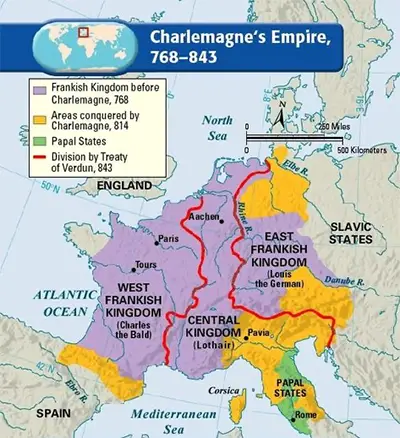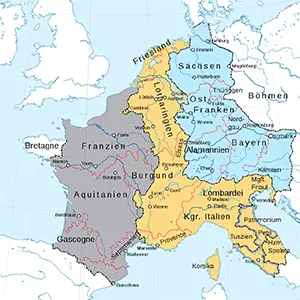The Treaty of Verdun
The Treaty of Verdun was a 9th-Century division of territory and governance designed to forestall a widening struggle between Frankish rulers. 
Charlemagne was the most famous and most successful of all rulers of the Franks. He founded the Holy Roman Empire in 800 and, when he died in 814, left a large amount of territory and responsibility to his only son, Louis. He became known as Louis the Pious because of his preference for religion and study and not military prowess. Charlemagne had angered Saxon leaders by his long campaign to subdue them. When he died, they took the opportunity to invade. Louis did his best to defend the realm but found it easier to pay the invaders not to come back. Louis had married twice, first to Ermengarde of Hesbaye in 794 and then, after she died, to Judith of Bavaria in 819. Louis had three surviving sons, Lothair and Louis from his first marriage and Charles from his second marriage. All three grew up watching their father have less and less success at fighting off enemies and keeping the realm together. Louis stated that his oldest son, Lothair, should succeed him as emperor; Louis had also divided the kingdom between his three sons. When their father died, in 840, the sons fought amongst one another for supremacy. 
Lothair claimed the entirety of the kingdom for himself, and his brothers joined forces to oppose him. Punctuating the fierce fighting was the large Battle of Fontenoy, fought on June 25, 841. Lothair had as an ally his nephew, King Pepin II of Aquitaine, making the strength of the opposing armies about equal. Charles and Louis were victorious, however, and Lothair abandoned the field and his claims to supremacy. The following year, Charles and Louis swore the Oaths of Strasbourg, allying themselves firmly against their brother. He, in turn, agreed to a settlement. The result was the Treaty of Verdun, signed on Aug. 10, 843. The treaty divided the realm into three kingdoms, each to be ruled by one of the brothers:
The three brothers lived out their lives ruling their separate kingdoms. |
|
Social Studies for Kids
copyright 2002–2024
David White



 Lothair got Middle Francia, or the middle part of Charlemagne's geographical legacy, which included northern Italy and, most importantly, the two imperial cities Aachen and Rome. He also got to retain the title of emperor, although his brothers pledged their loyalty to him in that regard.
Lothair got Middle Francia, or the middle part of Charlemagne's geographical legacy, which included northern Italy and, most importantly, the two imperial cities Aachen and Rome. He also got to retain the title of emperor, although his brothers pledged their loyalty to him in that regard.

